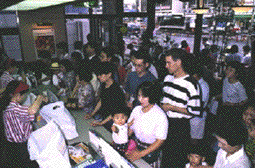
Fast-food restaurants serving beef hamburgers and other items are now a common sight in Japan. (Photo: McDonalds Co., (Japan) Ltd.)
BEEF CONSUMPTION RISING:
Propelled by Import Liberalization
and Yen Appreciation
JULY 15, 1996

Fast-food restaurants serving beef hamburgers and other items are now a common sight in Japan.
(Photo: McDonalds Co., (Japan) Ltd.)
Dietary Changes Bring Beef Consumption Close to Pork
Pork has always been the main meat item in the Japanese diet, particularly in the eastern part of the country, but now signs of changes are beginning to appear. Beef dishes grace family dining tables more frequently, while pork is seen less often.
A Prime Minister's Office survey of family budgets shows that the average amount of beef consumed annually per household (3.4 people) has risen 14% in the past five years, reaching 12.3 kilograms in 1995. In the same period, pork fell by 7.5% to 16 kilograms.
Propelled by the liberalization of beef imports in April 1991 and by yen appreciation, cheap imported beef from the United States, Australia, and other countries has become common on supermarket shelves and is well-received by consumers. Pork consumption peaked at 21 kilograms in 1980. At the time, beef consumption was 9.2 kilograms, less than half that of pork, which indicates the degree to which beef has gained popularity.
Regional Differences in Diet Shrinking
For a long time, people in the Kanto region of eastern Japan have favored pork; those of western Japan have preferred beef, and in fact, in the Kansai region the word "meat" is assumed to refer to beef. Conversely, buns filled with pork are called "nikuman" (meat buns) in Kanto but "butaman" (pork buns) in Kansai.
This regional difference has begun to shrink, particularly because of growing beef consumption in eastern Japan. In 1980 Kanto families ate only 65% of the national average for beef, but in 1995 this had risen to 83%. In the northern region the figure has risen from 31% to 59% and in Hokkaido from 19% to 50%.
The Kansai region consumes the most beef in the country (an average of 17.3 kilograms per household in 1995). In Kanto consumption has risen from 34% of Kansai consumption in 1980 to 59% in 1995, reducing the regional gap. Pork consumption is declining throughout the country, with the exception of Okinawa, and it seems that beef will become the star of meat dishes nationwide in the near future.
But compared with the United States, for example, where per capita average annual consumption is 31 kilograms, the Japanese still consume little beef. Given a further drop in price and the Westernization of young people's eating habits, however, the Japanese market for beef can be expected to continue growing.